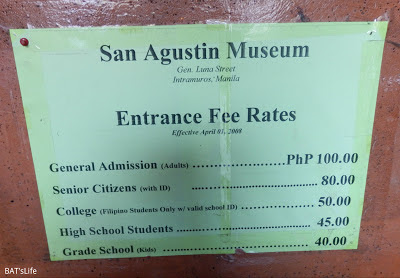San Agustin Museum (Intramuros, Manila)
On display are century-old pieces of furniture made of Philippine hardwoods such as Molave and Narra. Pieces of furniture made of-of Narra or Molave have withstood time and remained to be in very good condition. Years may have passed but the pieces of furniture seemed not to have been affected by the ravages of time. Investing in pieces of Narra or Molave furniture is really a good investment. Once you acquired items of furniture made of these hardwoods, the pieces can be handed down from one generation to the other. But now, Narra is considered to be an endangered species of hardwood. In fact, furniture made of pure Narra is very difficult to find.
Images and sculptures of Saints and other religious items made of now banned ivory are on display. During Spanish times, ivory seems to be the material of choice in making images of Saints. I was not able to take photos of the images as taking pictures, except in the hallways, is prohibited.
I really admired the effort employed in carving the statues and sculptures.
Visitors are charged an entrance fee to visit the museum. I find the fee very reasonable as you would learn a lot of things about Intramuros and Manila.
I really admired the effort employed in carving the statues and sculptures.
Visitors are charged an entrance fee to visit the museum. I find the fee very reasonable as you would learn a lot of things about Intramuros and Manila.
A very large bell greets visitors at the San Agustin Museum. I was amazed by the size of this bell. I think it is huge enough to be heard by all the residents within Intramuros. I can imagine how during Spanish times, this bell would wake up all devotees to head to the church and hear mass. The “Sacristans” just like Crispin and Basilio would laboriously climb the church tower to ring this very huge bell.
The ornately designed wooden door made of hardwood at the entrance of the museum merits admiration. I can imagine how visitors of the church and the faithful were amazed by the intricate details carved on this door.
The ornately designed wooden door made of hardwood at the entrance of the museum merits admiration. I can imagine how visitors of the church and the faithful were amazed by the intricate details carved on this door.
The ecclesiastical art and regalia that can be seen in the hallways and rooms of the museum show the evolution of the Augustinian Monastery and its Order.
The embroidered vestments worn by priests during the Spanish times are also on display. The vestments are richly decorated, unlike today.
There are several oil paintings of Saints, segments of Philippine history and former priests of the church. I think these paintings are already priceless or can fetch a very high value in auctions or in the art market. This collection of paintings show the many painters and artists who lent their talent and skill in depicting religious events and personalities.
If you happen to be in Manila, it is not a waste of time seeing the San Agustin Museum. It is a little creepy especially in the crypt where Juan Luna's remains are buried, yet you can learn a lot about the Augustinians and the history of Manila by just visiting the place.







Comments